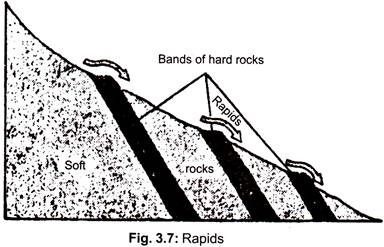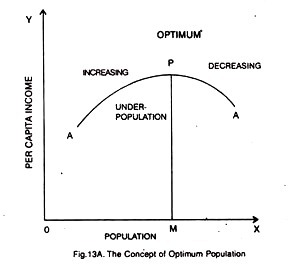ADVERTISEMENTS:
Groundwater or phreatic water is subsurface water which absolutely saturates the pore spaces above an impermeable layer.
Water found in the pore spaces, cracks, tubes, crevices beneath the surface has been termed as underground water, groundwater, subsurface water and subterranean water.
Sources of Groundwater:
There are four sources of groundwater:
(i) Connate water:
ADVERTISEMENTS:
At the time of rock formation water is trapped in the interstices of sedimentary rocks.
(ii) Meteoric water:
It originates in the atmosphere, falls as rain and ultimately becomes groundwater by infiltration. It forms the major part of groundwater.
(iii) Juvenile water:
It originates in the earth’s interior and reaches the upper layers of the earth’s surface as magmatic water.
(iv) Condensational water:
It is the prime source which replenishes water in deserts and semi-desert areas. During summer, land becomes warmer than the air trapped in the soil, which leads to a huge difference of pressure between the water vapour in the atmosphere and the water vapour trapped in the soil. Thus the atmospheric water vapour penetrates the rocks and gets converted into water due to falling temperature of the water vapour below.
ADVERTISEMENTS:
All the four sources get mixed along complex water-migration routes.
Occurrence of Groundwater:
More than half of all groundwater is available within 750 m of the earth’s surface. However, evidences of the presence of groundwater are also found at a depth of more than 11000 m, for instance in the Kola Peninsula of Russia. Water below the ground is available in four zones, viz., soil zone, intermediate zone, capillary zone and saturation zone.
The zone where water is available is called the zone of aeration. There are two forces which actively prevent groundwater from moving downward, viz., (a) the molecular attraction between water and the rock and earth materials and (b) the molecular attraction between water particles.
ADVERTISEMENTS:
The zone of aeration is further sub-divided into three layers—soil moisture zone, intermediate zone and capillary zone, collectively called Vadose Zone. Some amount of water in this zone is used by plants. At the bottom of the intermediate zone lies the capillary fringe (a thin layer of 2 to 3 cm) from where water moves upward. The capillary condition is temporarily destroyed when heavy rain takes place. In such cases the groundwater body is replenished by recharge.
The zone of saturation lies below the zone of aeration and is also called the phreatic zone. The water available in this zone is known as groundwater. The groundwater table or water table segregates the zone of aeration and the zone of saturation. The maximum elevation of water in a well which penetrates the groundwater zone is known as piezometric water table. Generally, the water table follows the irregularities of the earth’s surface; for example, the water table is highest beneath hills and lowest beneath valleys.
A geological structure fully saturated by water, capable of producing sufficient quantities of water that can be economically used and developed, is known as aquifer (Latin; to bear water). Examples include sandstone layer, unconsolidated sand and gravel, limestone, fractured plutonic and metamorphic rocks which act as aquifers. An aquifer can be broadly divided into (a) unconfined and (b) confined aquifers.
In the former case, water recharge may take place from lateral groundwater flow or from upward movement of water. The latter (also known as artesian or pressure aquifers) have an impermeable stratum that maintains hydrostatic pressure sufficient enough to raise water higher than the surface of the aquifer. Confining layers of the aquifer can be categorised into aquicludes, aquitards and aquifuges. Aquicludes form small saturated layers above the impermeable layers; examples are clay, shale and most of the igneous and metamorphic rocks.
Aquitards’ form confining layers but cannot completely check water flow to or from an adjacent aquifer. An aquifuge consists of a rock layer which has no interconnected opening or interstices. So it neither stores nor transmits water, for example, quartzite, obsidian. Water penetrates an aquifer through a recharge area which is exposed or is covered by a permeable zone of aeration. Water rises to the level of water table if digging can be done through the zone of aeration into the saturation zone.
Controlling Factors of the Occurrence of Groundwater:
The occurrence of groundwater is influenced by the following factors:
ADVERTISEMENTS:
Climate Groundwater is easily available at great depths in arid regions while it exists at shallow depth in humid regions. Water table rises during rainy season and sinks in dry season.
Topography the water table tends to be higher near the hilltops and lower near the valleys, because near the valleys water seepages into streams, swamps and lakes cause descending water table.
Types of Materials Porosity and permeability of the underground materials have an impact on the storage and movement of groundwater. The variability in porosity exists as the underground materials are heterogeneous in nature.
Porosity refers to the percentage of the total volume of rock with voids. Porosity determines the volume of water a rock body can retain. Four types of pore spaces are found—(i) Pore space between mineral grains, (ii) Fractures, (iii) Solution cavities, and (iv) Vesicles.
Permeability refers to the capacity of a rock body to transmit water. Sandstone and conglomerate are highly permeable because of the presence of relatively large interconnected pore space between the grains.
Nature and Movement of Groundwater The groundwater movement takes place through pore spaces at extremely slow velocity. The flow velocity of groundwater is expressed in metres-1 day. Water percolates from areas of high water table to the areas where water table is lowest i.e., towards lakes and surface streams.
Such differences of water table are known as hydraulic head. Groundwater percolates through the soil layers after being activated by gravity. Since the bottom layers of a soil are compact due to tremendous weight exerted by the overlying soil, permeability decreases downward. So, the vertical infiltration of water decreases and if the soil is situated on a slope groundwater deflects downslope as thorough flow.
The nature of groundwater at shallow depth reveals that it acts both as reservoir as well as conduit. Groundwater at shallow level forms a small but integral part of the hydrological cycle.
Precipitation falls on recharge areas where water adds up to the saturated zone. It moves ultimately to discharge areas i.e., areas where subsurface water is discharged to river or other water bodies. The areal extent of discharge areas is smaller than recharge areas.
In humid regions recharge areas are found everywhere except streams and adjacent floodplains whereas in arid regions recharge areas encompass only the mountains and bordering alluvial fans and also the major streams underlain by porous alluvium through which water percolates and recharges groundwater.
The fluctuation of water table is evident from the fact that in regions like the Indian subcontinent which experiences monsoon climate, the water table flattens and gradually the high water table beneath hills decreases to the level of valleys particularly during dry periods.
If the permeability of the ground remains uniform, the velocity of groundwater flow increases with an increasing gradient of slope of the water table (hydraulic gradient).




